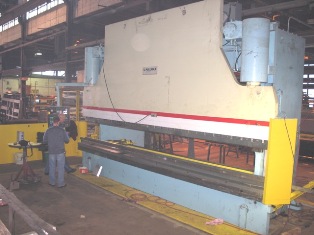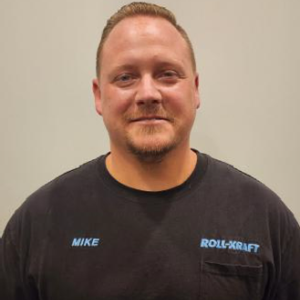Subscribe To Roll-Kraft
Receive the latest news from Roll-Kraft.

“Which is Best for Your Project?” Q. Is the per-piece cost generally less with metal roll forming, or press brake forming? A. Metal roll forming -- if there is a large number of parts to be made. The tooling cost is usually more for the roll formed shape but is spread over a larger quantity of parts, making the per-piece tooling cost less. If it is a short run and the shape is compatible with forming on a press brake, it is less costly to use a press brake. Q. So press brake is always preferable for small runs?
 A. It depends. Press brake forming generally requires more test blanks – scrap – and if the part is complex and precisely cut, and is made from a costly material, the expense of that scrap may tip the balance toward metal roll forming for a different reason. Many times the shape of the part is too intricate to do on a press brake. Q. Is there a difference in material cost between metal roll forming and press brake? A. The cost of the material is generally higher for press brake forming because the material has to be slit and sheeted-cut-to-length; metal roll forming accommodates very long parts lengths because the material is coiled. Q. Which method produces the highest parts accuracy? A. Press brake forming is regarded as an “art,” and varying levels of quality are a reality. Out-of-tolerance parts are salvaged or scrapped. Metal roll forming produces higher accuracy and a much lower percentage of out-of-tolerance parts. Q. Why does press brake forming produce less accuracy in parts than metal roll forming? A. The bend angles attempted with press brake forming are dependent on the specific material, its spring back properties, and the friction between the die and the blank during forming. In metal roll forming, the material is progressively bent, and it’s in contact with the forming dies for a longer time. The shape is reinforced by this lengthened contact, virtually eliminating spring back and making metal roll forming less affected by process variables.
A. It depends. Press brake forming generally requires more test blanks – scrap – and if the part is complex and precisely cut, and is made from a costly material, the expense of that scrap may tip the balance toward metal roll forming for a different reason. Many times the shape of the part is too intricate to do on a press brake. Q. Is there a difference in material cost between metal roll forming and press brake? A. The cost of the material is generally higher for press brake forming because the material has to be slit and sheeted-cut-to-length; metal roll forming accommodates very long parts lengths because the material is coiled. Q. Which method produces the highest parts accuracy? A. Press brake forming is regarded as an “art,” and varying levels of quality are a reality. Out-of-tolerance parts are salvaged or scrapped. Metal roll forming produces higher accuracy and a much lower percentage of out-of-tolerance parts. Q. Why does press brake forming produce less accuracy in parts than metal roll forming? A. The bend angles attempted with press brake forming are dependent on the specific material, its spring back properties, and the friction between the die and the blank during forming. In metal roll forming, the material is progressively bent, and it’s in contact with the forming dies for a longer time. The shape is reinforced by this lengthened contact, virtually eliminating spring back and making metal roll forming less affected by process variables.  Q. Do roll forming and press brake forming to have the same set-up times? A. No – the set-up for press brake is usually less than for roll forming but the production rate piece-per-hour is much higher for roll forming. The reason for this is that each piece does not have to be handled individually. Q. I have a 90-degree angle requirement on a 31’ part. We tried press brake forming; the dies marked the part – and we had to split the part into three sections. Is metal roll forming a good option for this application? A. With press brake forming, the part length can’t be any longer than the width of the brake press dies. Metal roll forming can do the full 31’ length – and will not mark the part. Q. Does either method offer an advantage in reducing the number of production steps? A. Depending on the shape of the part, metal roll forming can be done in one operation where using a press brake can require more than one hit. Also, depending on the part, holes, and cut-outs can be done with an inline pre-notch or the cut-off operation, and that will reduce the number of operations needed. This can be very significant in reducing cost and overall production time. Q. What about precoated or plated material? Does either method accommodate this? A. Both operations can be done on pre-plated or coated material, although metal roll forming usually leaves fewer and less visible marks on the part. Q. Why is radius bending such a difficult application for press brakes? A. One reason is the metal’s spring back may not be consistent from one sheet to another. Spring back is more of an issue for metals with higher tensile strengths. And the problem is exacerbated if the gauge or temper on long sheets of material varies. Radius bending is one task where metal roll forming is virtually always a better alternative. Q. Does the number of bends help determine whether metal roll forming or press brake forming is the better choice? A. A single bend is accomplished easily with roll forming or press brake. The advantage of metal roll forming is that it can produce multiple-precision bends over thousands of feet of material, quickly and very efficiently. Information by Moheco
Q. Do roll forming and press brake forming to have the same set-up times? A. No – the set-up for press brake is usually less than for roll forming but the production rate piece-per-hour is much higher for roll forming. The reason for this is that each piece does not have to be handled individually. Q. I have a 90-degree angle requirement on a 31’ part. We tried press brake forming; the dies marked the part – and we had to split the part into three sections. Is metal roll forming a good option for this application? A. With press brake forming, the part length can’t be any longer than the width of the brake press dies. Metal roll forming can do the full 31’ length – and will not mark the part. Q. Does either method offer an advantage in reducing the number of production steps? A. Depending on the shape of the part, metal roll forming can be done in one operation where using a press brake can require more than one hit. Also, depending on the part, holes, and cut-outs can be done with an inline pre-notch or the cut-off operation, and that will reduce the number of operations needed. This can be very significant in reducing cost and overall production time. Q. What about precoated or plated material? Does either method accommodate this? A. Both operations can be done on pre-plated or coated material, although metal roll forming usually leaves fewer and less visible marks on the part. Q. Why is radius bending such a difficult application for press brakes? A. One reason is the metal’s spring back may not be consistent from one sheet to another. Spring back is more of an issue for metals with higher tensile strengths. And the problem is exacerbated if the gauge or temper on long sheets of material varies. Radius bending is one task where metal roll forming is virtually always a better alternative. Q. Does the number of bends help determine whether metal roll forming or press brake forming is the better choice? A. A single bend is accomplished easily with roll forming or press brake. The advantage of metal roll forming is that it can produce multiple-precision bends over thousands of feet of material, quickly and very efficiently. Information by MohecoOn-Time Delivery
First Time Performance
Simply contact us here or call and get answers 24/7.
Contact Us (888) 953-9400
Roll-Kraft is pleased to announce the appointment of Mr. Mike Samplak to the position of Plant Manager at its headquarters facility in Mentor, OH.

Roll-Kraft is pleased to announce the appointment of Frank Lowery to Vice President of Roll Form Applications.

Roll-Kraft is pleased to announce the appointment of Kevin Gehrisch to the position of President.